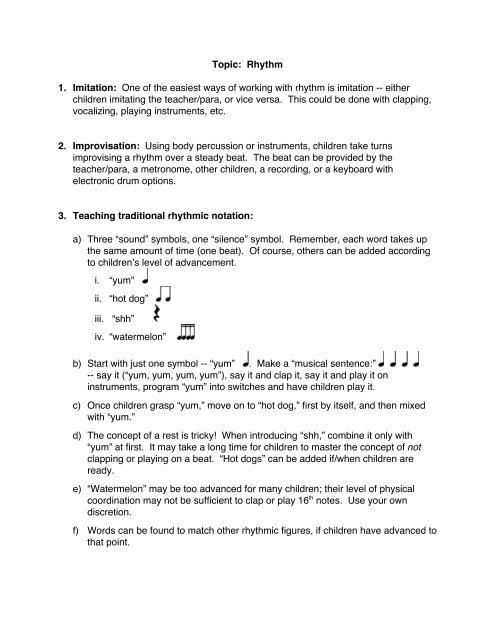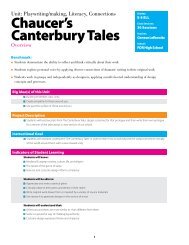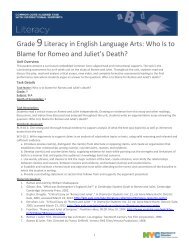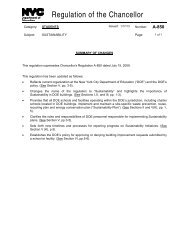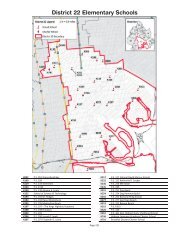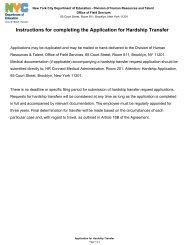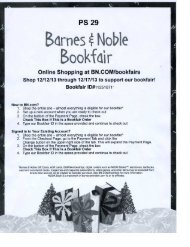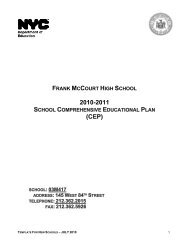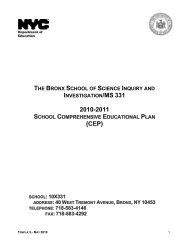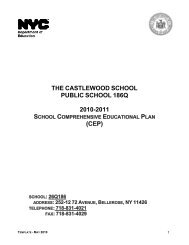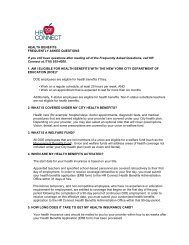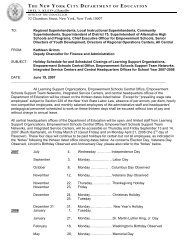Topic: Rhythm 1. Imitation: One of the easiest ways of working with ...
Topic: Rhythm 1. Imitation: One of the easiest ways of working with ...
Topic: Rhythm 1. Imitation: One of the easiest ways of working with ...
Create successful ePaper yourself
Turn your PDF publications into a flip-book with our unique Google optimized e-Paper software.
<strong>Topic</strong>: <strong>Rhythm</strong><br />
<strong>1.</strong> <strong>Imitation</strong>: <strong>One</strong> <strong>of</strong> <strong>the</strong> <strong>easiest</strong> <strong>ways</strong> <strong>of</strong> <strong>working</strong> <strong>with</strong> rhythm is imitation -- ei<strong>the</strong>r<br />
children imitating <strong>the</strong> teacher/para, or vice versa. This could be done <strong>with</strong> clapping,<br />
vocalizing, playing instruments, etc.<br />
2. Improvisation: Using body percussion or instruments, children take turns<br />
improvising a rhythm over a steady beat. The beat can be provided by <strong>the</strong><br />
teacher/para, a metronome, o<strong>the</strong>r children, a recording, or a keyboard <strong>with</strong><br />
electronic drum options.<br />
3. Teaching traditional rhythmic notation:<br />
a) Three “sound” symbols, one “silence” symbol. Remember, each word takes up<br />
<strong>the</strong> same amount <strong>of</strong> time (one beat). Of course, o<strong>the</strong>rs can be added according<br />
to children’s level <strong>of</strong> advancement.<br />
i. “yum”<br />
ii. “hot dog”<br />
iii. “shh”<br />
iv. “watermelon”<br />
b) Start <strong>with</strong> just one symbol -- “yum” . Make a “musical sentence:”<br />
-- say it (“yum, yum, yum, yum”), say it and clap it, say it and play it on<br />
instruments, program “yum” into switches and have children play it.<br />
c) Once children grasp “yum,” move on to “hot dog,” first by itself, and <strong>the</strong>n mixed<br />
<strong>with</strong> “yum.”<br />
d) The concept <strong>of</strong> a rest is tricky! When introducing “shh,” combine it only <strong>with</strong><br />
“yum” at first. It may take a long time for children to master <strong>the</strong> concept <strong>of</strong> not<br />
clapping or playing on a beat. “Hot dogs” can be added if/when children are<br />
ready.<br />
e) “Watermelon” may be too advanced for many children; <strong>the</strong>ir level <strong>of</strong> physical<br />
coordination may not be sufficient to clap or play 16 th notes. Use your own<br />
discretion.<br />
f) Words can be found to match o<strong>the</strong>r rhythmic figures, if children have advanced to<br />
that point.
4. Compose music using traditional rhythmic notation<br />
a) With <strong>Rhythm</strong> Cards: Create cards <strong>with</strong> <strong>the</strong> different rhythmic symbols on <strong>the</strong>m.<br />
Children arrange cards in <strong>the</strong> desired sequence, <strong>the</strong>n practice and perform.<br />
==> TIP: Cards can be laminated and Velcroed for ease <strong>of</strong> use. Bulletin boards<br />
and thumbtacks work for some populations as well.<br />
b) Create a score on chart paper: Children write down a rhythm on one line <strong>of</strong> a<br />
paper. Practice and perform.<br />
c) Compose poly-rhythmic music: Each line <strong>of</strong> music gets its own color. Lines can<br />
be performed simultaneously by dividing performers into two groups, each group<br />
using a different instrument or body percussion sound. Add additional lines as<br />
desired, depending on level <strong>of</strong> students. (This is not to be confused <strong>with</strong> using<br />
different colors for different pitches, discussed below.)<br />
q<br />
Œ<br />
q<br />
Œ<br />
q q q<br />
Œ<br />
Variations:<br />
i. <strong>One</strong> <strong>of</strong> <strong>the</strong> lines could be a BEAT (all “yums”)<br />
ii.<br />
Create an OSTINATO (a short rhythm that is repeated over and over); you<br />
can put more than one different ostinato toge<strong>the</strong>r to see how <strong>the</strong>y sound,<br />
or play a rhythmic ostinato while ano<strong>the</strong>r child improvises a rhythm.
5. Compose music combining rhythm and pitch (melodies): Use pitched<br />
percussion instruments <strong>with</strong> different colors for each pitch; for example, resonator<br />
bells, Remo Sound Shape drums, or Boomwhackers. (SEE ALSO “<strong>Topic</strong>: Pitch”)<br />
==> TIP: Please remember that at <strong>the</strong> beginning <strong>of</strong> any new activity, LESS IS<br />
MORE. In <strong>the</strong> following examples, a step-by-step approach to mastery would<br />
mean that very few choices would be presented at <strong>the</strong> beginning; for example,<br />
in activity 5a below, one might begin <strong>with</strong> all “yum” cards and <strong>the</strong> choice <strong>of</strong> only<br />
two different pitches. More rhythmic and pitch choices would be added<br />
gradually as students mastered previous stages.<br />
a) With Pitched <strong>Rhythm</strong> Cards: Create cards <strong>with</strong> notes on <strong>the</strong>m that match <strong>the</strong><br />
colors <strong>of</strong> <strong>the</strong> instruments you are using -- for example, if C resonator bell is red, a<br />
red “yum” card means that a quarter not is played on a C bell. (“Shh” symbols<br />
can remain black, as <strong>the</strong>y do not require a pitch.) Children arrange <strong>the</strong> cards in<br />
<strong>the</strong> desired sequence, <strong>the</strong>n practice and perform.<br />
q q q q q<br />
i. Music can be performed by one child -- for example, one child has all <strong>the</strong><br />
resonator bells and plays <strong>the</strong> melody by <strong>the</strong>mselves.<br />
ii. Music can be performed by multiple children -- for example, children get<br />
one pitch each and wait <strong>the</strong>ir turn to play when it’s time for <strong>the</strong>ir pitch.<br />
b) Create a score by writing <strong>the</strong> different-colored pitches on paper or chart paper.<br />
Scores can be played by one child or by multiple children, as described above.


